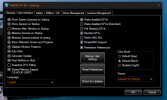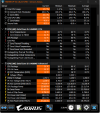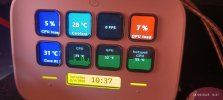You are using an out of date browser. It may not display this or other websites correctly.
You should upgrade or use an alternative browser.
You should upgrade or use an alternative browser.
alkis4
Member
Damn... welll, that was interesting after all
I think HWinfo saved my pc, ( I firstly installed it yesterday)
went back to Call of Duty game after a long time.
Game crashed after 30 minutes as my CPU spiked at 99 Celsius and I though it was game related problem but..
Eventually my water cooling diagram was not properly set up,
It was on balanced mode and even if the CPU was hot, water cooling radiator fans were running slow.
I adjusted the curve depending on the CPU temperature and now everything is okay.,
I hope I wasnt using my pc with high temperatures or
that 99 Celsius spike didnt harm my system.
I think HWinfo saved my pc, ( I firstly installed it yesterday)
went back to Call of Duty game after a long time.
Game crashed after 30 minutes as my CPU spiked at 99 Celsius and I though it was game related problem but..
Eventually my water cooling diagram was not properly set up,
It was on balanced mode and even if the CPU was hot, water cooling radiator fans were running slow.
I adjusted the curve depending on the CPU temperature and now everything is okay.,
I hope I wasnt using my pc with high temperatures or
that 99 Celsius spike didnt harm my system.
CPUs today have auto shutdown protection on critical temperature which in most cases is 105~110C, some up to 115C even.Damn... welll, that was interesting after all
I think HWinfo saved my pc, ( I firstly installed it yesterday)
went back to Call of Duty game after a long time.
Game crashed after 30 minutes as my CPU spiked at 99 Celsius and I though it was game related problem but..
Eventually my water cooling diagram was not properly set up,
It was on balanced mode and even if the CPU was hot, water cooling radiator fans were running slow.
I adjusted the curve depending on the CPU temperature and now everything is okay.,
I hope I wasnt using my pc with high temperatures or
that 99 Celsius spike didnt harm my system.
If this 99C was a recent thing and your CPU was not running there for weeks or months then it will most likely be ok.
Some CPUs have operational limit at 100C and others at 95C, 90C and 89C.
You still didn't state what CPU you have.
When just watching a video leads to such high temperatures, it means that the CPU cooling is insufficient. Ths could be due to an improperly mounted CPU cooler. Did you peel off the plastic from the coldplate before mounting the cooler? Does HWiNFO state in its sensors window that the CPU is throtteling, especially at such temperatures?
Some Intel features (e.g. power limits, multi-core enhancement) lead to higher temperatures but IMO 90°C is still a very high temperature for such a simple task, even when factoring in a few background tasks.
Some Intel features (e.g. power limits, multi-core enhancement) lead to higher temperatures but IMO 90°C is still a very high temperature for such a simple task, even when factoring in a few background tasks.
alkis4
Member
Thanks for your message. I have 2 monitors and multiple softwares on (discord,whatsapp,viber,chrome,mozila,stream deck,antivirus, etc)
when I first started this thread my software's water cooler settings were on balanced .
Now I have adjusted the curve depending on the CPU's temp and I when I play games, everything is cool.
Yes, I have removed the plastic.
and yes , I have made pop-up when temp reaches 90 degrees. (im messuring CPU Package)
I think this time that my CPU reached 90C it was just an instant spike, as I checked right away and temp went down to 60 and then 40 +
Here's my todays information If you are interested. (no gaming , just my regular schedule)
Its a really good software, thanks god I installed it that day..
I
when I first started this thread my software's water cooler settings were on balanced .
Now I have adjusted the curve depending on the CPU's temp and I when I play games, everything is cool.
Yes, I have removed the plastic.
and yes , I have made pop-up when temp reaches 90 degrees. (im messuring CPU Package)
I think this time that my CPU reached 90C it was just an instant spike, as I checked right away and temp went down to 60 and then 40 +
Here's my todays information If you are interested. (no gaming , just my regular schedule)
Its a really good software, thanks god I installed it that day..
I
When just watching a video leads to such high temperatures, it means that the CPU cooling is insufficient. Ths could be due to an improperly mounted CPU cooler. Did you peel off the plastic from the coldplate before mounting the cooler? Does HWiNFO state in its sensors window that the CPU is throtteling, especially at such temperatures?
Some Intel features (e.g. power limits, multi-core enhancement) lead to higher temperatures but IMO 90°C is still a very high temperature for such a simple task, even when factoring in a few background tasks.
Attachments
Hm, I don't know why the CPU Package Temp is more than 10°C higher than the CPU Core temps, although I'm well aware that a CPU has not just cores but other parts that can get hot. But it could be normal for Intel CPUs, I don't know, because I'm lacking experience with Intel CPUs  .
.
Anyway, 80°C CPU Core temps are much more reasonable and more or less expected when the CPU draws almost 160 Watts. However, I see that your PL1 and PL2 power limits are both set to 181 Watts. IIRC the PL1 - the long-term power limit - should be set to 125W to adhere to the Intel specs of this CPU. This is probably done by the motherboard. Check your BIOS if you can set the PL1 to a more reasonable value of 125W. Note that this can lead to a (very) minor reduction in performance, but it should bring the temperatures down.
Anyway, 80°C CPU Core temps are much more reasonable and more or less expected when the CPU draws almost 160 Watts. However, I see that your PL1 and PL2 power limits are both set to 181 Watts. IIRC the PL1 - the long-term power limit - should be set to 125W to adhere to the Intel specs of this CPU. This is probably done by the motherboard. Check your BIOS if you can set the PL1 to a more reasonable value of 125W. Note that this can lead to a (very) minor reduction in performance, but it should bring the temperatures down.
So true... Boards are pushing the default limits on Intel CPUs just to make themselves look good on reviews = selling point.Hm, I don't know why the CPU Package Temp is more than 10°C higher than the CPU Core temps, although I'm well aware that a CPU has not just cores but other parts that can get hot. But it could be normal for Intel CPUs, I don't know, because I'm lacking experience with Intel CPUs.
Anyway, 80°C CPU Core temps are much more reasonable and more or less expected when the CPU draws almost 160 Watts. However, I see that your PL1 and PL2 power limits are both set to 181 Watts. IIRC the PL1 - the long-term power limit - should be set to 125W to adhere to the Intel specs of this CPU. This is probably done by the motherboard. Check your BIOS if you can set the PL1 to a more reasonable value of 125W. Note that this can lead to a (very) minor reduction in performance, but it should bring the temperatures down.
125W long term and 180W short term should be more than plenty for gaming. On the other hand if the system is used for something like rendering and/or editing and such then performance will be tampered. But you cant have cake and eat it too...
Modern CPUs tend to spike occasionally to high temps for many reasons. The boost algorithm can be very aggressive on short low/medium loads with max frequency.I have the Intel(R) Core(TM) i5-14600KF 3.50 GHz
maybe I need to change the thermal paste too..
Now temps are fine that the fans of the water cooler are set to higher rpm , but yesterday i was watching youtube and still my CPU spiked for a sec on 90C .
Your CPU has max operating limit the 100C point. You can see the sensor "Core Distance to TjMAX" has dropped to 20C when CPU temp was 80C (80+20=100)
Meaning its allowed to run up to 100C but not all conditions are optimal for such temp and this a lot of users are not aware of. It depends on type of load, core count load, frequency, voltage, current draw (Amper) etc...
There is a function called "Intel TVB (Thermal Velocity Boost)" intagrated into the BIOS microcode that its supposed to manage this along with "Turbo Boost Max" function but a lot of boards are altering it for the sake of competition.
I am not entirely sure if this is on board vendors alone or if Intel is involved too, because who doesn't want to be more competitive.
If you stick to Intel defaults PL1 125W, PL2 181W you should be fine. Also be aware that Intel provides OC and extreme profiles on those CPUs even though its specified as a 125/181W CPU.
From Intel spec page:
Processor Base Power 125 W
Maximum Turbo Power 181 W
Intel® Core™ i5 processor 14600K (24M Cache, up to 5.30 GHz) - Product Specifications | Intel
Intel® Core™ i5 processor 14600K (24M Cache, up to 5.30 GHz) quick reference with specifications, features, and technologies.
Well, CPUs and motherboards tend to do that on their own these days - and I count increased power limits as overclocking.Also, I never overclock my pc , never really liked it..
Hard to say. It depends on many factors, e.g. the paste used, the environment the system is in (dry, humid, hot, cold, clean or dusty etc.) and how many heat cycles it has.how often should I change the thermal paste do you think ?
Usually a system can run many many years without repasting. My desktop system which I use every day has been running since 2019 without any change to its hardware or its thermal paste. My server - regular desktop hardware in a midi-tower - which runs 24/7 ran for a decade before I finally swapped the CPU a couple of years ago and renewed the thermal paste in the process.
In short: I doubt it's necessary to repaste after less than two years.
alkis4
Member
Thank you very much.Well, CPUs and motherboards tend to do that on their own these days - and I count increased power limits as overclocking.
Hard to say. It depends on many factors, e.g. the paste used, the environment the system is in (dry, humid, hot, cold, clean or dusty etc.) and how many heat cycles it has.
Usually a system can run many many years without repasting. My desktop system which I use every day has been running since 2019 without any change to its hardware or its thermal paste. My server - regular desktop hardware in a midi-tower - which runs 24/7 ran for a decade before I finally swapped the CPU a couple of years ago and renewed the thermal paste in the process.
In short: I doubt it's necessary to repaste after less than two years.
Should I enable Snapshot CPU Polling ??

Also, is there a way for HWinfo to start automatic without me to have to click the start button ??
Thanks in advance,
If you guys ever come to Greece for holidays, contact with me for help and informations.
alkis4
Member
Thanks Martin,"Snapshot CPU Polling" is for AMD CPUs only.
Enable "Auto Start" or disable the "Show Welcome Screen...".
Greece - maybe this summer
If you want you can contact with me for any suggestions or whatever, Im in the tourist industry for some years now. Be sure to get a discount for a car rental as you guys are willing to help people here
www.araxosrentacar.com you can find us here. we are located in the mainland ( a good traditional and economic destination with many choices )
but I have some people in the islands too if you need any help.
alkis4
Member
Yes, I have HWiNFO running all the time.
I have added the most important temperature sensors - CPU, chipset, GPU and all 3 drives - to the tray notification area (TNA aka system tray) so that I can see them at a glance. That's something SpeedFan can't do, but Motherboard Monitor did back in the 2000/XP days; yes, I'm that old .
.
I have added the most important temperature sensors - CPU, chipset, GPU and all 3 drives - to the tray notification area (TNA aka system tray) so that I can see them at a glance. That's something SpeedFan can't do, but Motherboard Monitor did back in the 2000/XP days; yes, I'm that old
Similar threads
- Replies
- 1
- Views
- 1K


